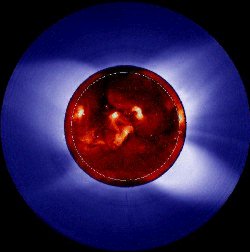The Fate of the Sun
About 5 billion years from now, the hydrogen near the center of the Sun
will begin to run out and the helium that has collected there will start
to contract. This will increase the rate of hydrogen burning in a shell
around the core. Our star will slowly bloat into a
red
giant and destroy the inner planets of our solar system, including the Earth.
As the helium core continues to contract from gravity, it will soon get
dense and hot enough to fuse three helium particles into carbon. At the
same temperature, the carbon can also fuse with another helium to form
oxygen. Since the Sun is not very massive compared to some stars, it will
never get hot enough in the center to create elements much heavier than
carbon and oxygen. These elements will collect in the center of the star.
Later it will shed most of its atmosphere, creating a planetary nebula,
and emerge as a hot white dwarf star.
Nearly 99 percent of all stars in the galaxy will end their lives as white
dwarfs. By studying the stars that have already gone through this process,
we can learn about the fate of our own Sun.
You might also be interested in:

IMF stands for Interplanetary Magnetic Field. It is another name for the Sun's magnetic field. The Sun's magnetic field is enormous and is carried by the solar wind. The solar wind and magnetic field are
...more
"Without warning, the relatively calm solar atmosphere can be torn asunder by sudden outbursts of a scale unknown on Earth. Catastrophic events of incredible energy...stretch up to halfway across the visible
...more
The Sun is not a quiet place, but one that exhibits sudden releases of energy. One of the most frequently observed events are solar flares: sudden, localized, transient increases in brightness that occur
...more
The visible solar atmosphere consists of three regions: the photosphere, the chromosphere, and the solar corona. Most of the visible (white) light comes from the photosphere, this is the part of the Sun
...more
To understand how our Sun works, it helps to imagine that the interior of the Sun is made up of different layers, one inside the other. The innermost layer, the solar core, is the region where the energy
...more
Scientists at the High Altitude Observatory (HAO) are working to understand the changes we see in the Sun over time, and how these changes affect the atmosphere of the Earth. There are four main areas
...more
Energy from the Sun is one of the primary drivers of the Earth system. The Sun warms our planet, heating the atmosphere. This energy feeds atmospheric processes and is a primary driver of our weather.
...more
The basic Hydrogen fusion cycle involves four Hydrogen nuclei (protons) and two electrons and yields a Helium nucleus, two neutrinos and six photons. This process occurs in three steps: the first one is
...more















